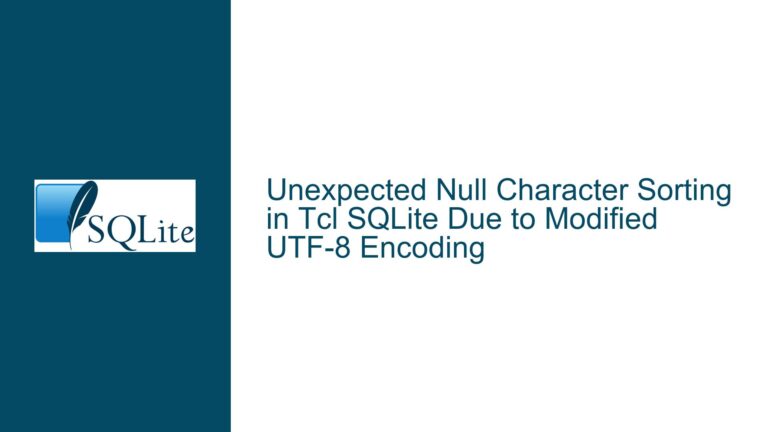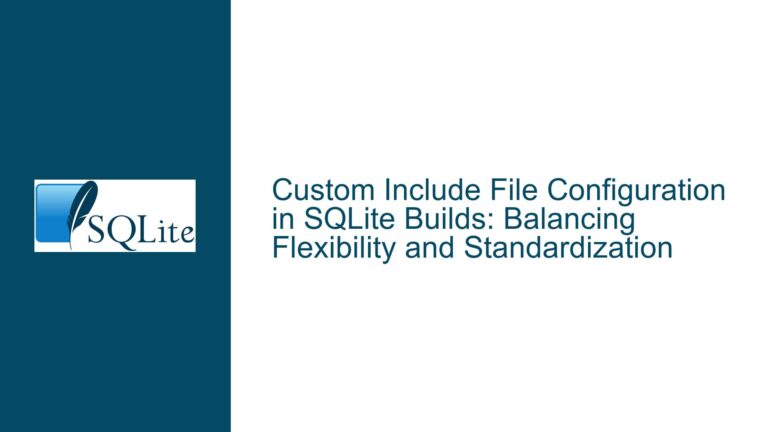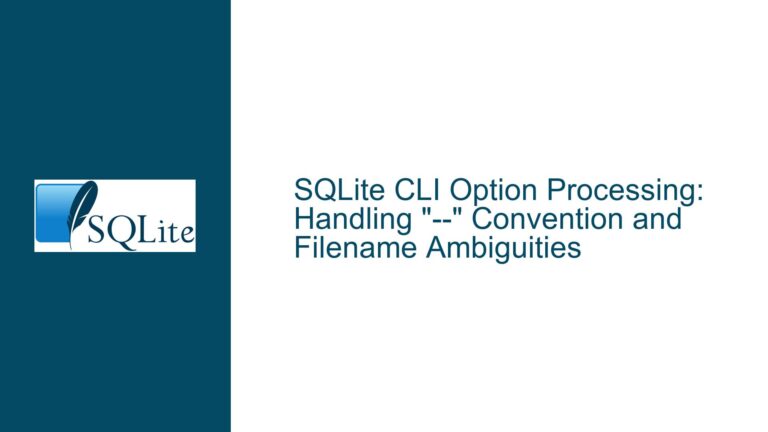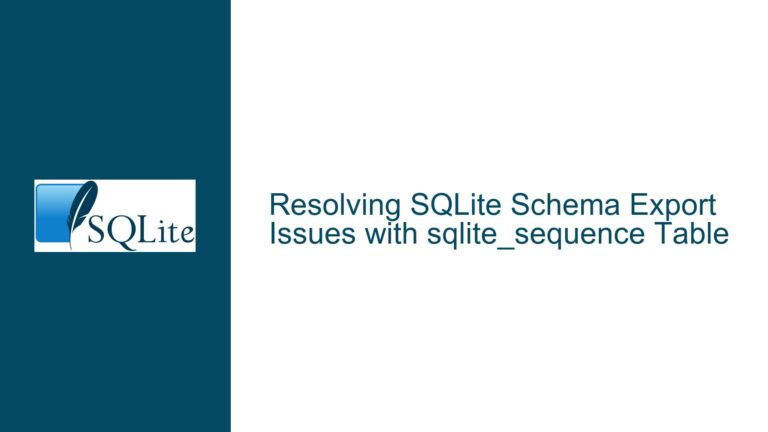SQLite Statement Subtransaction Journals and Their Use Cases
Statement Subtransaction Journals: Ensuring Atomicity in SQLite Operations
SQLite is renowned for its lightweight, serverless architecture and its ability to handle transactions with atomicity, consistency, isolation, and durability (ACID) properties. One of the lesser-known but critical components that enable SQLite to maintain atomicity at the statement level is the statement subtransaction journal. This journal is a temporary file or in-memory structure that SQLite uses to ensure that individual SQL statements can be rolled back if they fail, even if they are part of a larger transaction. Understanding how statement subtransaction journals work is essential for database developers who want to optimize their SQLite schemas and queries, especially in scenarios involving complex transactions or error handling.
A statement subtransaction journal is not the same as a savepoint or a traditional rollback journal. While savepoints allow for partial rollbacks within a transaction, and rollback journals ensure the atomicity of entire transactions, statement subtransaction journals focus on the atomicity of individual SQL statements. This distinction is crucial because it allows SQLite to handle statement-level failures gracefully without compromising the integrity of the overall transaction. For example, if an INSERT statement fails due to a constraint violation, the statement subtransaction journal ensures that the effects of that specific statement are rolled back, while the rest of the transaction can proceed unaffected.
The use of statement subtransaction journals is particularly important in scenarios where SQLite performs large or complex operations that could potentially fail midway. For instance, when executing a DELETE statement that affects multiple rows, SQLite uses the statement subtransaction journal to record the state of each row before modification. If the statement fails after modifying some rows, the journal allows SQLite to revert those changes, ensuring that the database remains in a consistent state. This mechanism is also used in UPDATE statements, INSERT statements with constraints, and other operations that require atomicity at the statement level.
Interrupted Write Operations and the Role of Statement Subtransaction Journals
One of the primary scenarios where statement subtransaction journals come into play is during interrupted write operations. SQLite is often used in environments where power failures, application crashes, or other interruptions can occur unexpectedly. In such cases, the statement subtransaction journal acts as a safeguard, ensuring that incomplete or failed statements do not leave the database in an inconsistent state.
Consider a scenario where an application is executing a large UPDATE statement that modifies thousands of rows. If a power failure occurs midway through the operation, the database could be left with some rows updated and others unchanged, leading to data inconsistency. However, because SQLite uses a statement subtransaction journal, it can detect the interruption and use the journal to roll back the changes made by the incomplete statement. This ensures that the database remains consistent, even in the face of unexpected interruptions.
The statement subtransaction journal also plays a critical role in handling constraint violations. For example, if an INSERT statement attempts to insert a row that violates a unique constraint, SQLite uses the journal to roll back the insertion, ensuring that the constraint is not violated. Similarly, if a DELETE statement encounters a foreign key constraint violation, the journal allows SQLite to revert the deletion, maintaining referential integrity.
Another important use case for statement subtransaction journals is in nested transactions or savepoints. While SQLite does not support true nested transactions, it does support savepoints, which allow for partial rollbacks within a transaction. When a savepoint is created, SQLite uses the statement subtransaction journal to record the state of the database at that point. If a rollback to the savepoint is later requested, SQLite uses the journal to revert the changes made since the savepoint was created. This mechanism ensures that savepoints can be used effectively to manage complex transactions without compromising atomicity.
Implementing PRAGMA journal_mode and Best Practices for Managing Statement Subtransaction Journals
To effectively manage statement subtransaction journals and ensure optimal performance, SQLite provides the PRAGMA journal_mode command. This command allows developers to configure how SQLite handles journals, including statement subtransaction journals. The available journal modes include DELETE, TRUNCATE, PERSIST, MEMORY, WAL (Write-Ahead Logging), and OFF. Each mode has its own trade-offs in terms of performance, durability, and resource usage, and choosing the right mode depends on the specific requirements of the application.
The DELETE journal mode is the default mode in SQLite. In this mode, SQLite creates a separate journal file for each transaction or statement, which is deleted once the transaction or statement is completed. This mode provides a good balance between performance and durability, making it suitable for most applications. However, it can result in increased I/O overhead due to the creation and deletion of journal files.
The TRUNCATE journal mode is similar to DELETE, but instead of deleting the journal file, SQLite truncates it to zero bytes. This reduces the I/O overhead associated with file deletion, making it a more efficient option for applications that perform a large number of small transactions. However, it may not be as durable as DELETE in some cases, as the truncated file may still occupy disk space until it is overwritten.
The PERSIST journal mode takes a different approach by leaving the journal file on disk after the transaction or statement is completed, but marking it as inactive. This reduces the I/O overhead associated with file creation and deletion, but it can result in increased disk usage over time. The PERSIST mode is suitable for applications that prioritize performance over disk space usage.
The MEMORY journal mode stores the journal in memory instead of on disk. This provides the best performance, as it eliminates the I/O overhead associated with disk-based journals. However, it also reduces durability, as the journal is lost if the application crashes or the power fails. The MEMORY mode is suitable for applications that can tolerate some data loss in exchange for improved performance.
The WAL (Write-Ahead Logging) journal mode is a more advanced option that provides both high performance and durability. In this mode, SQLite writes changes to a write-ahead log file instead of modifying the database file directly. This allows multiple readers to access the database simultaneously while a single writer makes changes, improving concurrency. The WAL mode also reduces the need for statement subtransaction journals, as it provides a more efficient mechanism for ensuring atomicity and consistency.
Finally, the OFF journal mode disables journaling entirely. This provides the best performance, but it also eliminates the safeguards provided by statement subtransaction journals, making it unsuitable for most applications. The OFF mode should only be used in scenarios where data integrity is not a concern, such as temporary databases or read-only databases.
In addition to configuring the journal mode, developers can also optimize the use of statement subtransaction journals by following best practices. For example, minimizing the size and complexity of individual SQL statements can reduce the overhead associated with journaling. Using batch operations instead of individual row operations can also improve performance, as it reduces the number of journal entries that need to be created and managed. Finally, regularly backing up the database and monitoring disk usage can help ensure that the database remains consistent and efficient, even in the face of unexpected interruptions or failures.
By understanding the role of statement subtransaction journals and implementing best practices for managing them, developers can ensure that their SQLite databases remain consistent, performant, and reliable, even in the most challenging environments. Whether you’re working on a small embedded system or a large-scale application, mastering the nuances of SQLite’s journaling mechanisms is essential for building robust and efficient database solutions.






